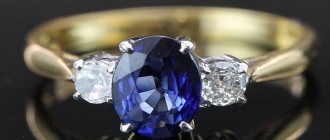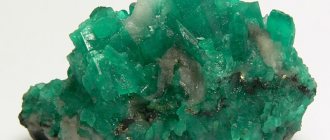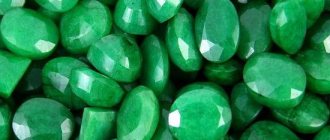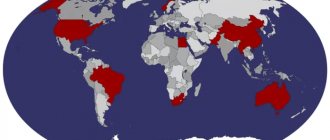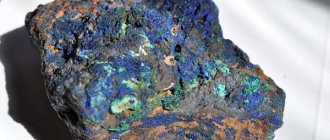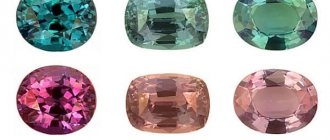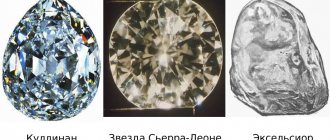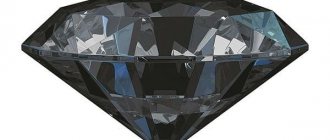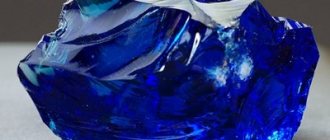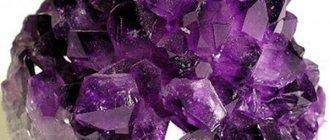Inspecting precious stones, calculating their weight and classifying stones by color and clarity is the assessment of their value. In most jewelry appraisals, the stones make up the majority of the value.
When evaluating jewelry stones, the main characteristics that are taken into account are color, clarity, cut and size. In some cases, the formation of the price of precious stones is influenced by the geography of the deposit.
When evaluating jewelry with colored stones, you must answer the following questions:
- what kind of stone is this (its name),
- whether it is natural stone or synthetic,
- Is the stone a good cut?
- are there many inclusions in it that negatively affect its beauty,
- Is the color of the stone beautiful?
- Is the color of the stone natural?
- whether the stone has been refined.
Origin of the gemstone
Historically, stones from certain deposits are taken as the standard for the quality of a particular stone. Thus, rubies from Burma, sapphires from India, and emeralds from Colombia are considered the most prestigious and beautiful. The price of such stones may have a premium to the list price of up to 30%.
Emerald from Colombia
It is quite difficult to establish from which deposit a particular stone was mined. Evidence must be based on in-depth studies of the various types of inclusions and defects that stones from different deposits have. But there are some features that suggest the place of origin.
Thus, the presence of chromium as a coloring agent in Burmese rubies is often the reason for their strong luminescence, which is noticeable under artificial light. This luminescence makes the color of the stone more saturated; often the stone seems to be illuminated from within, flickering like a hot coal. In daylight, such a stone may appear pale pink. The same applies to rubies from Sri Lanka.
Thai rubies owe their color to the presence of iron, and therefore have a brown tint, slightly reminiscent of garnet. Iron absorbs luminescence, and as a result, under artificial light, Thai rubies do not exhibit the same fire as Burmese and Sri Lankan rubies. In daylight the difference is not so obvious.
Kashmir sapphires retain their color under artificial light, which is not typical for sapphires from other deposits. Sri Lankan sapphires change color the most; under artificial light they turn almost purple.
In addition, stones from each region are characterized by special inclusions. Colombian emeralds have inclusions of “three stages” at once: these are flat cavities with jagged edges filled with liquid and also containing crystals or gas bubbles. In addition, small crystals of calcite or fluorite can be found in Colombian stones. Emeralds from Sandawana are characterized by tremolite inclusions that look like long needles.
Refinement of jewelry stones
Refining jewelry stones, i.e. improving their quality and color, is a process that dates back to ancient times. When evaluating jewelry with precious stones, it is necessary to determine whether the stones have been treated. It is also important to remember that so-called compound stones are most often found in antique products. Composite stones are stones made up of several parts. There are two types of compound stones - doublets and triplets.
Doublets are created by joining two pieces of genuine stone together using a colored adhesive, causing the stone to appear "larger" or a more pleasing color. Triplets are assembled from three parts.
The most common are false doublets, in which the upper part is garnet, emerald, sapphire, ruby, and the lower part is glass. Opal doublets are very common.
Doublets can be identified by the junction of two parts in the girdle area: when examined, a thin strip of binder can be seen between the two parts.
Tourmaline triplet
Today you need to know that many technologies for refining stones are completely “legal” and cannot be considered fraud. However, some processing methods should not be used for certain types of stones, since the changes that occur are not permanent and over time the color may become the same as it was before.
Determining the shape and type of cut
Faceted is a stone with flat polished surfaces - edges. The concept of "cut" includes the proportions and finishing of a gemstone. It also refers to the shape or design resulting from the processing process.
Various types and shapes of jewelry stones
The shape and type of cut of a gemstone should ensure its external beauty, a high degree of play and brilliance. For some stones there is a basic (traditional) shape: for emerald - emerald shape ("octagon"), for sapphires - oval, etc.
The type of cut is determined by the pattern and the number of edges applied to the insert. The shape of the cut is determined by the shape of the girdle contour in plan.
Cut shapes
Processing quality assessment
When assessing the quality of processing of a jewelry stone, the beauty, attractiveness, practicality of the shape given to the stone, its size, how easily the stone can be set into a product, as well as excess weight, which does not add anything to the beauty aspect of the stone, are taken into account. When assessing the overall cut, the finishing is taken into account (the quality of polishing and the absence of chips).
International recommendations for cutting fancy stones
The main dimensions of stones, size ratios, radii of joints, tolerances and maximum deviations for stone parameters are given in accordance with OST 25.770-87:
A (perfect. These are the optimal angles of inclination of the edges of the crown and pavilion, excellent polishing; cutting of the edges of the crown is not allowed.
B (good). This is the correct symmetry; the surface may have small scratches and tool marks if polished sufficiently well; There may be dispersed microchips and screes on the girdle, up to 0.1 mm in size, barely visible to the naked eye, but easily visible at 10x magnification. Discount 5 -10%.
B (satisfactory). These are obvious cut flaws that are easily visible to the naked eye; deviations from the correct geometric shape; non-parallelism of the platform relative to the girdle plane; deviation of the insert tenon relative to the axis; scratches, chips of girdle and tenon up to 0.2 mm in size; poor polishing. Discount 10 - 30%.
G (bad). These are significant cutting flaws visible to the naked eye: asymmetrical arrangement of edges, severely disrupted proportions, significant surface distortion, large scratches and chips on the entire surface of the stone, or poor polishing. Discount 30 - 50%.
Deviation of the insert tenon relative to the axis
Reference tables for market valuation of jewelry stones
The table below shows the color characteristics of popular jewelry stones, their prices and availability. Prices are given only for faceted jewelry stones. Stones cut in the cabochon style are often cheaper. Prices are given for stones of “good” and “extra-high” quality. Commercial quality stones that are used in mass produced items cost significantly less. Prices are given in a range. Moreover, the greater the spread of prices for any stone, the greater the importance of qualitative differences in gemological characteristics.
Market prices for jewelry stones
| Name of the stone | Color | Market prices (retail) USD per carat | Availability |
| aquamarine | pale blue to moderate blue | 1-5 ct: 50-600 5-10 ct: 170-1200 | Often in stock |
| emerald | yellow-green to bluish-green | 1-2 ct: 1150-18000 2-4 ct: 2000-25000 | high quality ones are rare, others are usually available for sale |
| alexandrite | changes color from greenish in daylight to reddish in incandescent light | 1-2 cart:2200-18000 | large ones are rare |
| ruby | from red to yellow-red | 1-2 ct: 900-10000 2-4 ct: 1800-32000 | high-quality ones with natural color are very rare |
| blue sapphire | bright blue to inky blue | 1-2 ct: 300-2900 2-4 ct: 1200-14000 | Kashmiri ones with natural color are rare, others are quite common |
| green sapphire | pure green to yellowish green | 1-3 ct: 40-180 3-5 ct: 100-220 | Pure green color is rare, others are quite common |
| pink sapphire | light to dark pink | 1-2 kt: 600-4800 2-3 kt: 800-5600 | with a weight of up to 1 carat it is quite common |
| yellow sapphire | yellow (most stones are heat treated | 1-5 ct: 120-1200 5-10 ct: 400-1500 | large ones are rare, others are at a good level |
| Moonstone | Milky white to bluish white | Up to 1 carat: 50-180 3-4 carats: 800-1200 | white is at a good level, other colors are at a satisfactory level |
| garnet (almandine) | purplish red to pure red | 1-5 ct: 10-40 5-10 ct: 16-60 | at a satisfactory level |
| garnet (demantoid) | from yellow-green to bright green | 1-2 cart: 800-1800 2-3 cart: 2000-12000 | at a satisfactory level |
| garnet (rhodolite) | red-violet | 1-5 ct: 20-180 | at a satisfactory level |
| garnet (spessartine) | brown-orange to reddish-brown | 1-5 cart: 8-60 5-30 cart: 24-160 | nAt a satisfactory level |
| pearls cult. round | silver, silver-white, white, cream | threads 6-6.5 mm:500-2000 8-8.5 mm:1700-11000 9-9.5 mm:4400-27000 | high quality more than 8 mm is rare |
| pearls cult. South Sea | silver, silver-white, white, cream | for one pearl 11-12 mm: 1500-5600, over 16 mm: 12500-25000 | high quality more than 16 mm is rare |
| pearls cult. rice | all colors | standard threads: 5-20 | at a good level |
| Pearl cult. Tahiti | black dark gray to greenish undyed | for one pearl 9-10.5: 800-3600, over 12 mm: 2500-5000 | small at a good level of high quality more than 10 mm is rare |
| peridot (peridot) | yellow-green to dark green | 1-5 ct:25-150 5-10 ct:50-130 | Large ones are rare |
| amethyst | from violet-red to dark purple | 1-5 ct: 6-125 5-20 ct: 10-150 | at a good level |
| citrine | yellow to yellow-brown | 1-20 ct: 5-60 | at a good level |
| spinel | pink-red-brown | 1-3 ct: 70-1200 3-5 ct: 150-4000 | at a good level |
| blue topaz | blue, bright blue | 1-5 ct: 2-16 5-20 ct: 200-1600 | at a good level |
| pink topaz | pink, yellowish pink | 1-3 ct: 150-1500 | at a good level |
| tourmaline | wide color range | 1-3 ct: 40-360 5-10 ct: 120-800 | at a good level |
| zircon | pale blue (usually cooked) | 1-5 ct: 30-300 5-10 ct: 70-500 | at a good level |
| noble white opal | with opalescence in blue and green tones | 1-12 ct: 50-170 | at a good level |
| fire opal | bright orange | 1-10 ct: 200-1400 | at a good level |
All gemologists, regardless of their experience, from time to time encounter a stone that they cannot clearly identify. This situation requires consultation with another gemologist or gemological laboratory. In such a case, inform your client of the identification problem and delay the evaluation until the issue is resolved.
In some cases, frames may prevent clear identification. In order to solve this problem, you just need to remove the stone from the setting. Be sure to obtain a written release of liability from your client before beginning this procedure.
